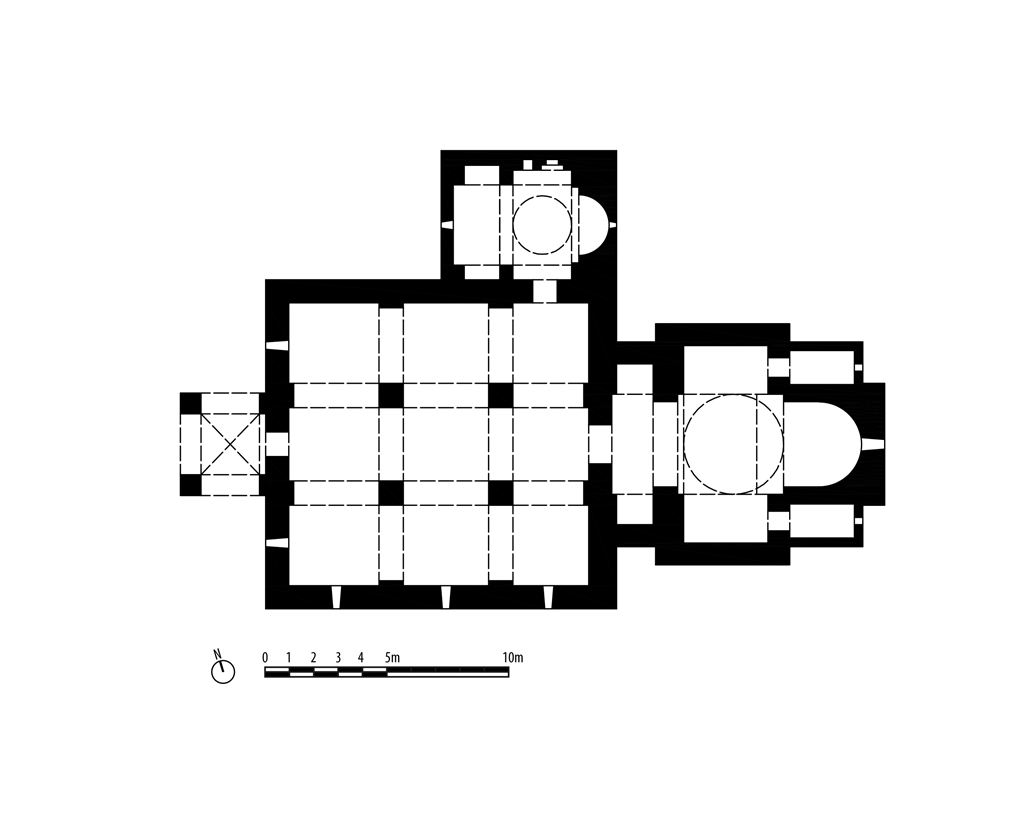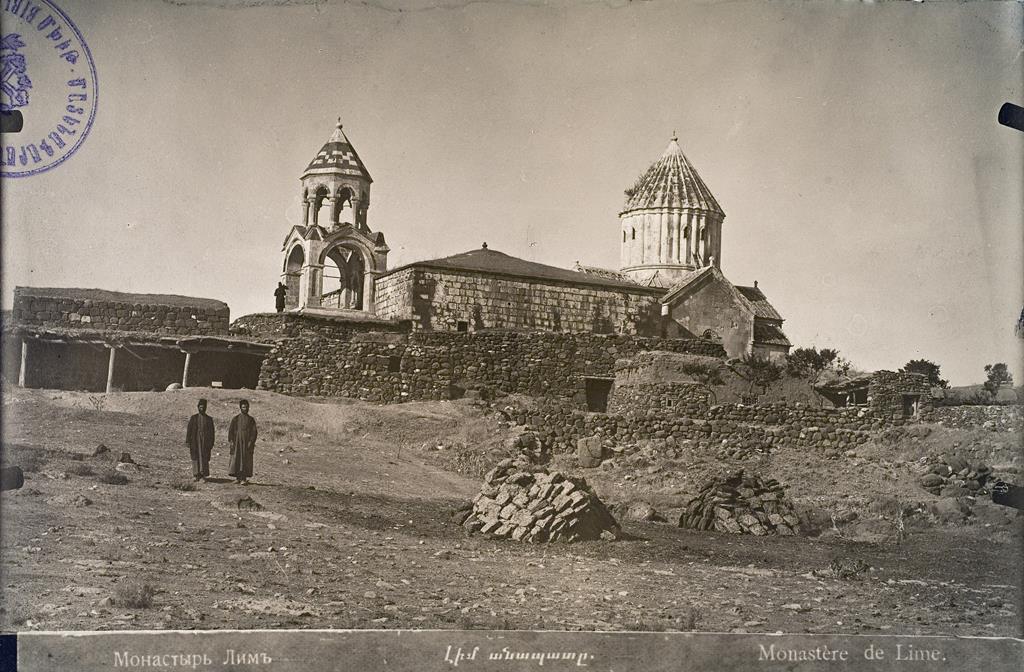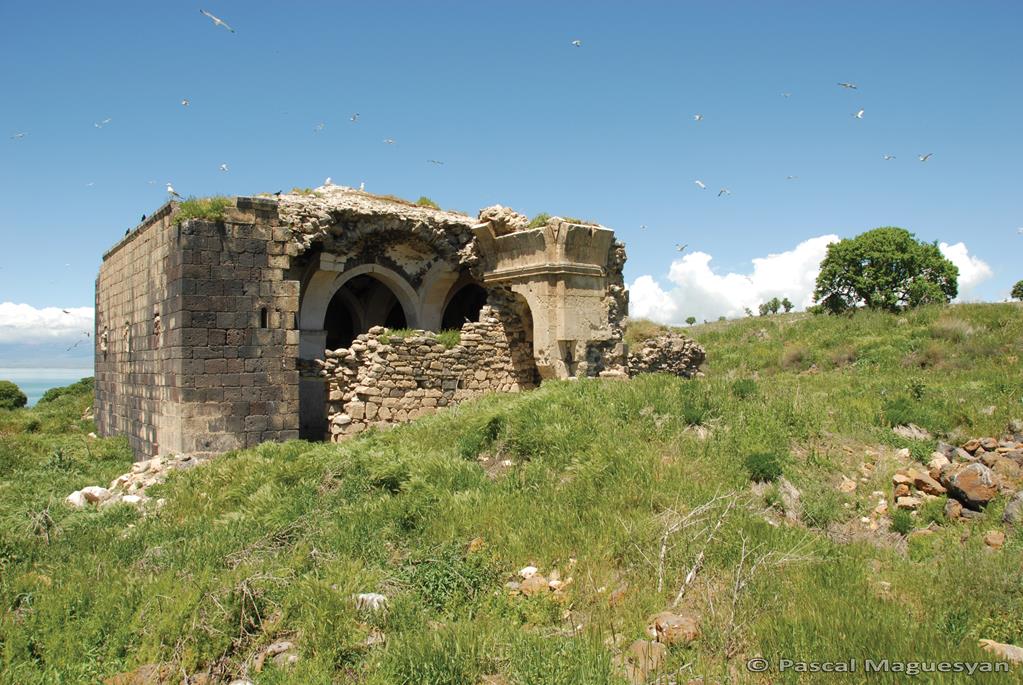The hermitage or desert of Lim [Adır-Yaka Adası] is built on the island of the same name in Lake Van. The largest of the lake’s islands, it is located a short distance from the eastern shore at 38° 52’ N and 43° 21’ E.
A manuscript dating from the 13th-15th centuries indicates that the hermitage was founded before 884; it is attested in 1301 and remained an active scriptorium and convent until the 20th century. The main church, dedicated to Saint George, was restored or rebuilt in 1301 by Catholicos Zacharia I of Aghtamar (Zak‘aria, 1300-1336), of the Sefedinian branch of the Ardzrunid royal family of Vasbouragan. Among the famous priors of Lim, we find the poet Zacharia of Knunik († after 1576), a contemporary of the poet and catholicos, Gregory I of Aghtamar (Krikoris Aght‘amartsi, catholicos from 1512 to 1545). The Lim community was revitalized in the 17th century by the arrival of a new prior, Nerses of Mogs (Nerses Mogatsi, 1622-1625), originally from the Amirdol monastery (n° 59); at that time Lim had some sixty monks. Nerses’ impetus established it as a strong monastic school of philosophy, whose influence lasted into the 19th century. For the greater part burned or thrown in the water in 1538 by the commander of the Van Fortress, Sultan Gogja, Lim’s library was gradually built up again, and in 1693 had 3,124 volumes, mainly manuscripts. Around 1900, the collection stood at 550 manuscripts together with some 3,000 printed volumes. Remarkably, despite the introduction of printing in Armenian communities as early as 1512 – something not allowed in Ottoman Armenia until 1857 – Lim’s scriptorium was still operating in 1914. Lim was plundered in 1848, 1896 and one last time in 1915. The library of the Institute Machtots, or Madenataran, devoted to ancient manuscripts from Yerevan, holds 306 manuscripts from Lim.

Plan (Thierry, 1989, 181)
The monastic complex at Lim includes the church of SaintGeorge, built in 1310, a cross in square with a polygonal drum adorned with pilasters and coiffed by a fluted pyramid; a vast narthex with four central pillars built at the west entrance to the church in 1766 and preceded by a bell tower; and finally, the Holy Zion chapel, with its single nave surmounted by a cupola, abutting the narthex on the north side but probably dating from the 9th or at least from the beginning of the 14th century. To this must be added a set of buildings that make up Lower Lim (Nerkin Lim) and the cemetery, with its numerous cross-stones and old graves, among which that of Nerses of Mogs. The domain of the Lim hermitage covers the entire island: it included vegetable gardens and orchards, as well as an externs’ house (trsi doun) on the opposite shore, and properties in Van. Among the hermitage’s other possessions were the priories of Our Lady (Khatun Diramor Vank), Edchmiadzni Vank, the Holy Mother of God (Surp Asdwadzadni Vank ) and Saint Sahag of Ererin (Ererna Surp Sahag), situated near the shore or on Mount Khashlkukh [***], between the islands of Lim and Gduts. In 1915, the Lim and Gduts convents were under a single abbot with jurisdiction over 25 parishes and 32 churches, and were attached to the Armenian Patriarchate in Constantinople. The last superior ofLim was Father Hovhannes Hussian: we are indebted to him for saving, in 1915-1916, 1,450 old manuscripts conserved in the monasteries of Lake Van, and in the churches of Van and vicinity. Unfortunately, an even greater number of manuscripts were destroyed.

General view looking southwest (Mekhitarist Congregation in Vienna)
The Lim hermitage and its domains were confiscated after the Great War and left empty and derelict. The monument seems to have been dynamited or bombed. The church of Saint Gregory was still standing in the 1950s but has been almost totally destroyed since; the narthex has partially collapsed and the bell tower has been demolished; the cemetery was searched and ravaged; but the Holy Zion chapel can still be seen. Lower Lim lies in ruins. Among the hermitage’s priories only Saint Sahag still has its little church. All the others have been destroyed.

Narthex with site of the church in the foreground, 2011 (P. Maguesyan Coll.).
Oskian, 1940-1947, I, 3-51. Thierry, 1989, 172-175, 177-184. Devgants, 1991, 258-265.